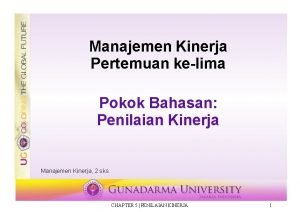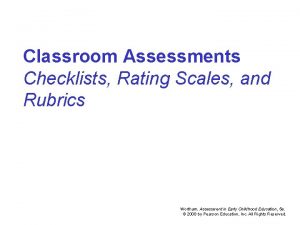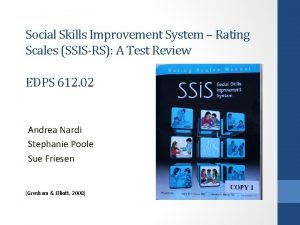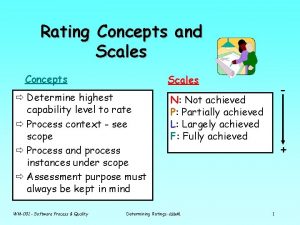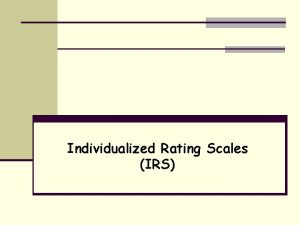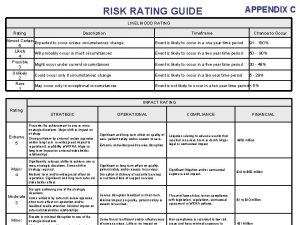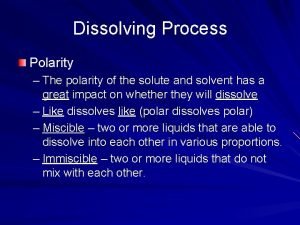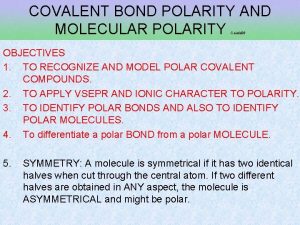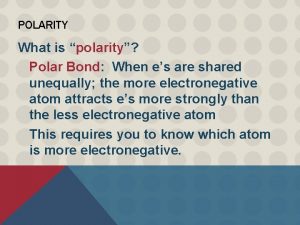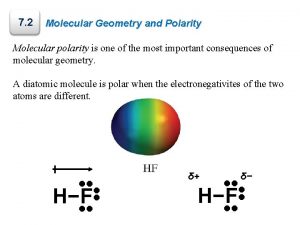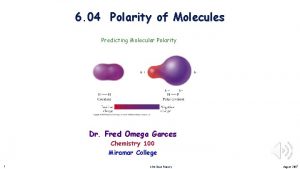Does the polarity of rating scales matter How

























- Slides: 25

Does the polarity of rating scales matter? How unipolar, bipolar and mixed rating scales affect measurements with latent variables Natalja Menold 5 th Conference of the European Survey Research Association (ESRA), 15 -19 July, 2013

Content • • • Introduction: Polarity and mixed scales Research questions Study design Results: Concept 1 and Concept 2 Conclusions

3 Scale Polarity Krosnick & Fabrigar , 1997 Bipolar: Scales reflecting two opposing dimensions • agree-disagree, like-dislike, -5…+5 Unipolar: reflect varying levels of the same dimension with a zero point on the one end • do not agree at all -fully agree; not important – very important, 0 -10 Meaning of the middle category • in bipolar scales: neither nor, partly-partly • in unipolar scales: a moderate position

4 Mixed scales in Surveys ESS blue print ISSP 2007 B 3: bipolar Very difficult Difficult Neither difficult nor easy Easy Very easy moderately? D 20 a: Mixed Not at all important Not important Neither important nor unimportant Important Very important 12 a-e: DE Mixed stimme voll und ganz zu stimme zu weder noch stimme nicht zu stimme überhaupt nicht zu 12 a-e: AU Mixed stimme voll und ganz zu stimme zu teils / teils stimme nicht zu stimme überhaupt nicht zu

Response Sets Attraction to middle category (Korman 1971) as Middle Response Set (MRS): respondents tend to use the middle category more often than other categories Positivity bias: Reluctance to give negative evaluations resulting in tendency to overuse the positive end of the scale (e. g. Landy & Farr, 1980; Lau, Sears, & Centers, 1979) Response set: tendency (affected by situation) to respond to questionnaire items on some basis other than the item content (Paulhus, 1991)

Factors Associated with Response Sets Need for accuracy (Kruglanski, 1989) • personality variable, extent to which individuals are motivated to be as accurate as possible Need for cognition (NFC, Cacioppo & Petty, 1982) • personality variable, extent to which individuals are inclined towards effortful cognitive activities Attitude strength (AS, Petty & Krosnick, 1995; Bassili & Krosnick, 2000) • Strong attitudes: highly pronounced, with a high impact on cognition and behavior

Research Questions • How does variation in polarity using verbal labels and mixing middle category affect • measurement quality of latent variables? • attitude values measured with latent variables? • Which is the role of… • response sets (MRS and positivity bias)? • tendency to be accurate, need for cognition and attitude strength?

Methods • A randomized 2 x 2 between-subject experimental design, varying polarity and middle category • Analysis of measurement quality of latent variables: – Factorial validity (CFAs, MLR with Mplus) • R 2 of items as items‘ reliability • Loadings (min. λ =. 30) as items validities (e. g. Andrews, 1984) – Internal consistencies (Cronbach‘s α; min. α =. 60) • SEM with structural and measurement components and covariates (MLR with Mplus) • Web Survey: GESIS Online Access Panel • A probability sample of German residents: N = 552, 53% males, age M = 42. 63, SD = 14. 77

Items and Constructs Women’s labour force participation (ALLBUS 2008) 2 Factors: CFA, MLR: CMIN (8) = 56. 52, p <. 001; RMSEA =. 04; CFI =. 99 r = -. 81; loadings between. 54 and. 88 • F 1: Employed mothers: 3 items, e. g. a little child would suffer when the mother is employed • F 2: Women as wife: 3 items, e. g. a married women should better support the husband in his career than make her own career Economic values (ALLBUS 2004) 2 Factors: CFA, MLR: CMIN (13) = 66. 52, p <. 001; RMSEA =. 037; CFI =. 93; r =. 24; loadings between. 38 and. 89 • F 1: Government intervention: 2 items, e. g. Government should ensure that everybody has a job and that prises are stable. • F 2: Inequality: 5 items, e. g. economic rewards are fairly shared in Germany / even though one would want, social differences in Germany could not be lower than those currenly are.

Realization of rating scales Women’s labour force participation: 7 categories Economic Values: 5 categories Bipolar (Bip) lehne völlig ab / lehne eher ab /teils-teils /stimme eher zu / stimme zu/ stimme voll und ganz zu fully disagree……partly-partly ……fully agree Bipolar Mixed (Bip. Mix) lehne völlig ab / lehne eher ab / in der Mitte / stimme eher zu/stimme zu / stimme voll und ganz zu fully disagree ……. . in the Middle…. . fully agree Unipolar Mixed (Unip. Mix) stimmt überhaupt nicht / stimmt wenig/ teils-teils / stimmt ziemlich/stimmt voll und ganz does not apply at all ……partly-partly…. fully applies Unipolar (Uni) stimmt überhaupt nicht / stimmt wenig / stimmt mittelmäßig /stimmt / stimmt ziemlich / stimmt voll und ganz does not apply at all…. . moderately applies…. fully applies

Covariates • Conscientiousness (accuracy and thoroughness): 5 items, a subscale of BFI-K (Rammstedt & John, 2005) • Need for cognition (NFC): 16 items of a German NFCscale (Bless et al. , 2006) • Attitude Strength Topic importance * certainty when answering the items related to the topic.

Women’s labour force participation Model fit of CFAs Bip. Mix Unip 23. 26** 15. 36* 8. 56 10. 62 a CFI . 91 . 96 1. 00 . 99 RMSEA . 12 . 08 . 02 . 04 . 07 -. 18 . 00 -. 14 . 00 -. 11 . 00 -. 011 132 138 134 130 CMIN (df = 8) 90% C. I. of RMSEA N - pure model fit in the case of bipolar scale - close fit in the case of unipolar scales adf = 9

Women’s labour force participation Item and Factor Statistics R 2 of items 1 2 3 4 5 6 λ of items f 1 1 3 5 f 2 2 4 6 r(f 1, f 2) Bip . 24. 09. 42. 44. 50. 86 . 49. 65 -. 71. 30 -. 66 -. 93 Bip. Mix . 47. 46. 70. 58. 47. 44 . 69 -. 83. 68. 67. 76. 67 Unip. Mix . 45. 28. 53. 99. 42. 41 . 67 -. 73. 65. 53 1. 00. 64 Unip . 45. 47. 56. 86. 39. 59 . 67 -. 75. 63. 68. 93. 77 . 86 -. 66 -. 75 -. 71 Bip and Unip. Mix: Low reliabilities of several items Bip: The highest factor intercorrelation; sign differs from other scales

Women’s labour force participation Cronbach‘s Alpha f 1 f 2 Bip . 76 . 83 Bip. Mix Unip . 77 . 71 . 72 . 74 . 77 . 84 Mixed scales: lower internal consistencies of factor 2

Women’s labour force participation SEM NFC C AS a 1 f 1 MID MRS a 3 a 5 NEG a 2 POL f 2 a 4 a 6 NFC Need for cognition C Conscientiousness AS Attitude Strength MID: non-mixed = 1 mixed = 2 POL: bipolar = 1 unipolar = 2 MRS: middle responding NEG: Negativity: usage of the negative part of the scale Indirekt effects of POL, MID and interaction on f 1 and f 2 are not presented

-. 18*** -. 16*** NFC . 14** C AS. 33*** -. 09** -. 38*** MID . 10* MRS f 1 -. 56*** -. 75*** a 3 -. 30*** -. 17** -. 37* a 5 . 5 -. 63*** . 21*. 34** a 1 1 -. 24** -. 70*** NEG -. 88*** POL -. 16***. 33***. 06* NFC C -. 20*** f 2 -. 25*** AS a 2 a 4 a 6 Covariates NFC, C: no or small effects Effect of AS - the higher AS the lower MRS - the higher AS the higher NEG 1 . 5 CMIN (49) = 137. 18*** RMSEA =. 06 90% C. I. of RMSEA. 05 -. 07 CFI =. 96 SRMR =. 04

-. 18*** -. 16*** NFC . 14** C No sign. direct effects of MID, POL and interaction term on f 1/f 2 AS. 33*** -. 09** -. 38*** MID -. 37* MRS -. 17** -. 56*** -. 63*** . 21*. 34** POL -. 30*** . 10* f 1 NEG -. 20*** 1 a 1 Sign. direct effects of MRS and NEG on f 1 and f 2 -. 75*** a 3 Sign. direct effect of MID on MRS: higher MRS for mixed . 5 a 5 Sign. direct effect of POL on MRS and NEG: - higher MRS for unipolar -. 70*** - lower NEG for unipolar 1 a 2 Sign. direct effects of interaction term -. 88*** -. 24** -. 16***. 33***. 06* NFC C f 2 -. 25*** AS a 4 a 6 . 5

Women’s labour force participation MRS Interactions NEG partly-partly

Indirect Effects MID f 1 -. 02*. 11**. 08** -. 07** -. 19* -. 10** POL MRS NEG . 21** f 2 - Sign. indirect effects of polarity and interaction term on factors

Economic Values: Results of CFAs Bip. Mix Unip 28. 86* 21. 49 16. 14 33. 67** CFI . 93 . 95 . 98 . 80 RMSEA . 07 . 04 . 11 . 02 -. 12 . 00 -. 10 . 07 -. 17 132 138 134 130 CMIN (df = 13) 90% C. I. of RMSEA N Acceptable results for both mixed scales; best model fit for unipolar mixed scale

Economic Values Item and scale statistics R 2 of items 2 3 4 5 6 7 8 λ of items f 1 3 4 f 2 2 5 6 7 8 r(f 1, f 2) Bip . 33. 36. 75. 05. 22. 58. 34 . 60. 87. 58. 23. 47. 76. 59 Bip. Mix . 30. 68. 30. 17. 20. 53. 64 . 83. 55. 41. 45. 73. 80 Unip. Mix . 45. 56. 66. 11. 20. 54. 66 . 75. 81. 67. 33. 44. 73. 81 Unip . 31. 63. 35. 13. 14. 52. 35 . 79. 55. 36. 37. 72. 58 -. 46 -. 62 -. 25 -. 31 Biplar scale: Low reliability and validity of item 5 Higher (negative) factor intercorrelations in bipolar scales

Economic Values Cronbach‘s Alpha f 1 f 2 Bip . 68. 64 Bip. Mix Unip . 62. 71 . 75. 71 . 63. 60 Factor 1: a higher value in unipolar mixed Factor 2: low values in bipolar and unipolar

Economic Values Summary of SEM results - Bipolar and unipolar mixed scale: higher MRS and positivity bias - No, little effects of Need for cognition and Conscientiousness; An effect of Attitude Strength - MRS and positivity bias are mediators of rating scale effects on factor measurements

Conclusions • • • Polarity does matter! Bipolar (non mixed) scale: poor measurement quality Effect of rating scales on factor values Attitude Strength is an important covariate variable MRS and NEG (=positivity bias) are mediators of effects on the factor measurements • Mixed scales and measurement quality – > more research is needed – > number of categories should be considered

Thank you! contact: natalja. menold@gesis. org
 Molecular shapes polar or nonpolar
Molecular shapes polar or nonpolar Whats a polar bond
Whats a polar bond What is graphic rating scale
What is graphic rating scale Meeting performance
Meeting performance Checklists and rating scales are used as
Checklists and rating scales are used as Sales performance appraisal
Sales performance appraisal Performance levels
Performance levels Behaviorally anchored rating scale
Behaviorally anchored rating scale Ssis age range
Ssis age range Good measurement
Good measurement Riset rating dan non rating
Riset rating dan non rating Paper chromatography polarity
Paper chromatography polarity Section 1 composition of matter
Section 1 composition of matter White matter of brain
White matter of brain Classification of matter section 1 composition of matter
Classification of matter section 1 composition of matter Chapter 2 section 1 classifying matter answer key
Chapter 2 section 1 classifying matter answer key What makes up the diencephalon
What makes up the diencephalon Section 1 composition of matter chapter 15 answer key
Section 1 composition of matter chapter 15 answer key Gray matter and white matter
Gray matter and white matter Gray matter
Gray matter Energy naturally flows from warmer matter to cooler matter
Energy naturally flows from warmer matter to cooler matter Polarity of water
Polarity of water Pollen polarity
Pollen polarity Polarity analysis
Polarity analysis Reference polarity
Reference polarity Honors chemistry
Honors chemistry



